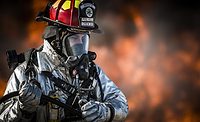In a Friday morning press conference at Northern Illinois University, university officials, NIU police and city police all agreed that the various agencies responding to the 911 call yesterday at about 3:06 pm were communicating well with each other. Two University officers arrived near the scene within seconds of calls for help; city police were not far behind. Seven people died in the attack, including the shooter by his own hand. The March 2008 issue of Security Magazine will have significant coverage of mass notification at colleges and universities and a survey of first responder communications. What follows is a preview of some of that coverage.
Communication during an emergency doesn’t get anymore critical or technologically complex then when it comes to public safety incidents. A just-released national survey to assess how public safety organizations use current communications technology and what future capabilities they would deploy reveals a strong demand for technology solutions that provide advanced situational awareness to first responders, improved incident coordination and streamlined emergency response.
The survey results, conducted by the Association of Public-Safety Communications Officials (APCO) and Motorola, have lessons for chief security officers (CSOs) seeking ways to improve their own emergency communications and mass notification efforts.
NATURAL DISASTERS TOP WORRY
A top concern of first responders nationwide is their ability to react to natural disasters (65 percent), superseding both terrorist attacks (7 percent) and crime (10 percent). Regional fire and police officials dually note that advanced communications technology ranks as the most critical aid in preparedness and response both now and in the future. And while technologies are improving, community officials report that the greatest need for improvement from advanced technologies in public safety arises in terms of range, speed and availability (26 percent); interoperability (25 percent); and availability of equipment (17 percent). Topping responders’ “wish lists” were rugged notebook computers, visual identification and recognition capabilities, and smart transportation navigation.
The survey also uncovered areas for improvement within departments, as well as additional communications needs for responders and communities. Community officials in both large and small populations listed mapping technologies, or GPS tracking, as the top tool they’d hope to see used as technology continues to evolve in the security and safety arena.
The survey also examined the varying needs of police departments, fire departments, emergency medical services and public administrators. Fire officials regard traffic light sensor technologies (41 percent) as critical to their needs, while police departments rely more heavily on mobile video systems (63 percent). With regard to areas needing improvement, fire departments would like to have better availability of mapping technology (35 percent); police officials are more likely than fire officials to volunteer that they face continuing challenges with interoperability (51 percent).
ENTERPRISE SECURITY SHARES TECH USE
Enterprise security video systems also are going mobile, probably faster than public safety; and there is a push to interface corporate security video streams with first responders coming to the site of an incident.
“Improving communications and providing critical information to emergency responders helps save lives,” said Richard Mirgon, first vice president of APCO. “This survey indicates that better-informed users are more effective in their jobs and the continuing advancement of technologies gives our first responders the tools necessary to protect themselves and the public.”
The survey also studied concerns, areas of progress and broad technology demand trends among users in urban and rural areas. Responders based in urban or suburban settings are more likely to value improved data availability and access (20 percent) as their greatest benefit. Conversely, those in rural environments are more likely than their counterparts to cite the range, speed and availability of equipment (35 percent) as most critical. Larger communities of 100,000 or more report technology as most helpful in providing situational awareness to incident response (4.6 on a five-point scale) over smaller pools of less than 10,000, who cite the aid of technology in interoperability between county agencies (4.4 on a five-point scale) as most helpful.
Public safety officials from large and small population areas similarly point to more training for first responders (25 percent) and the need for additional responders (29 percent) as areas that are in need of increased attention, based on the allocation of funds.
The public safety communications wish list matches needs articulated by many CSOs.
· Satellite tracking of vehicles (47 percent)
· Visual identification and recognition capabilities
o Facial recognition (37 percent)
o Automatic license plate recognition (41 percent)
· Rugged notebook computers (26 percent)
· GPS (25 percent)
· Smart transportation navigation systems
o Mobile video systems (30 percent)
o Traffic light sensors (31 percent)
Sidebar 1 with photo and caption:
Emergency Notification for Online Users
There has been a lot of talk about reverse 911, emergency telephone and intercom systems, e-mail and portable outdoor broadcast equipment to get the word out during an emergency on a corporate or university campus.
However, there’s yet another effective method, especially geared to enterprises where most every worker has a networked computer. Systems now exist that work within the network to flash emergency information over worker computer screens.
One example, the Enterasys Enterprise Notification System (ENS), redirects all Web browser traffic to a secure notification portal. Once implemented, any authorized security executive, emergency responder or law enforcement official can access the system following simple, intuitive instructions. The authorized individual creates the notification message, determines its severity (i.e. color-coded threat advisory or weather alert), selects who will see the message, then transmits the message in seconds with a single click. All Web communications for every online user or temporary visitor will be redirected to the “emergency” Web page which displays the real-time notification message. Once the message has been read and acknowledged, the user/guest is routed back to their originally requested Web page in just one click.
Such systems can interface with existing short message service, e-mail and voicemail response systems to protect existing investments and align disaster response procedures to ensure business continuity. Designed to work with multi-vendor network infrastructures, ENS, for instance, requires no major reconfiguration or disruption to network operations.
Benefits of this approach include:
• Notify anyone online in the building or across the campus, leveraging the broad accessibility and use of Web browsers and Internet communications.
• No need for prior registration or active participation of employees, students, users or guests.
• Increases confidence and sense of security for the entire building or campus community




